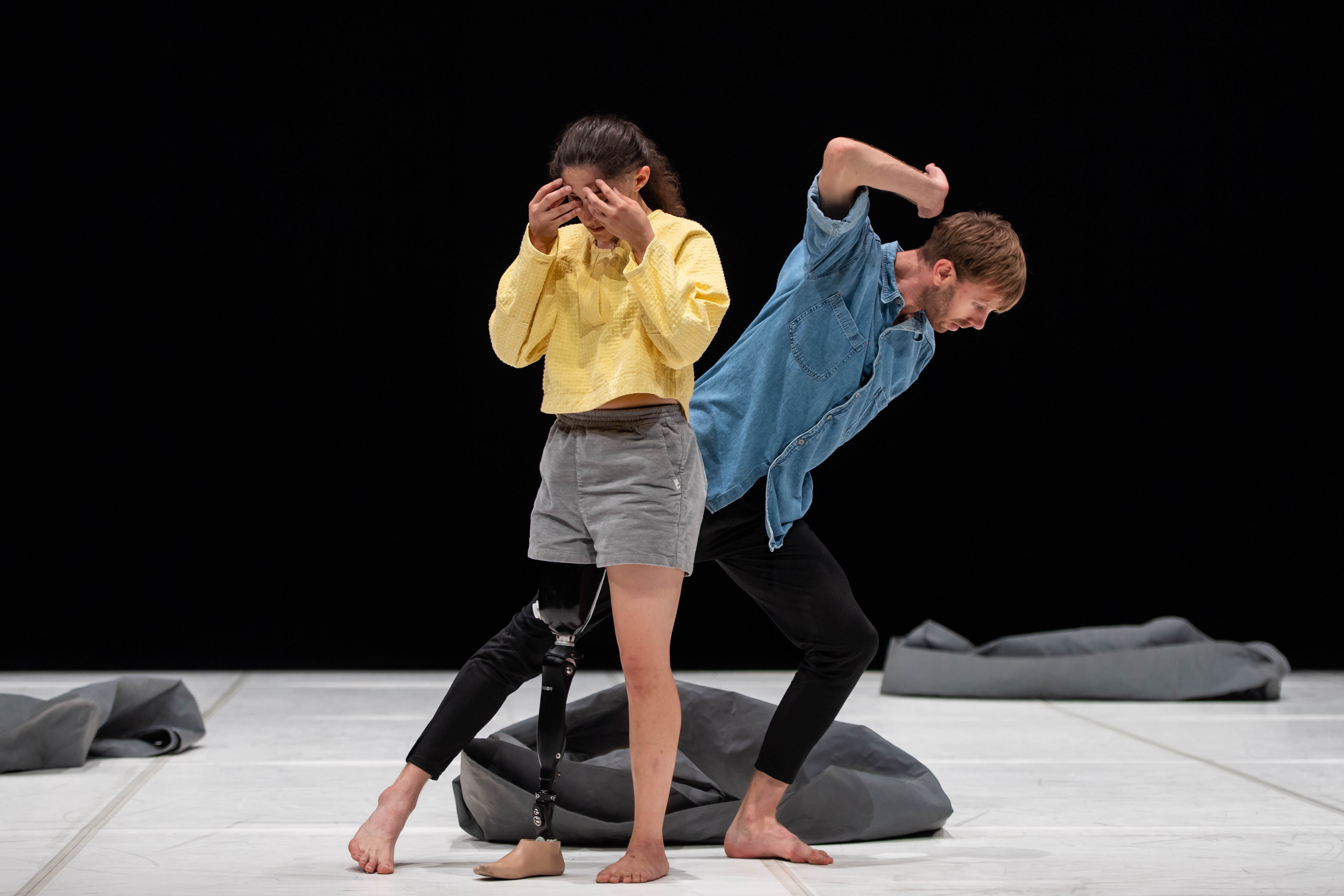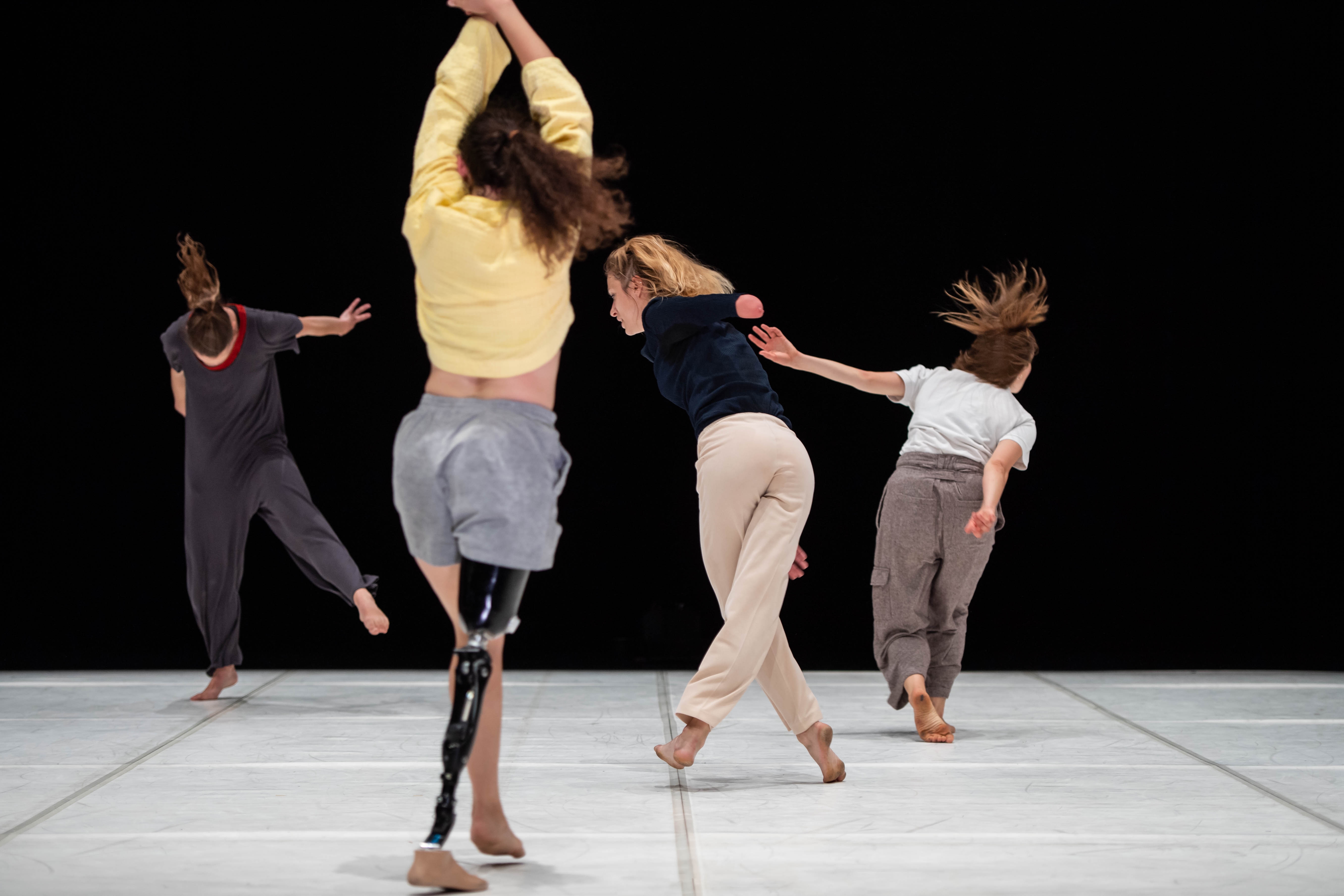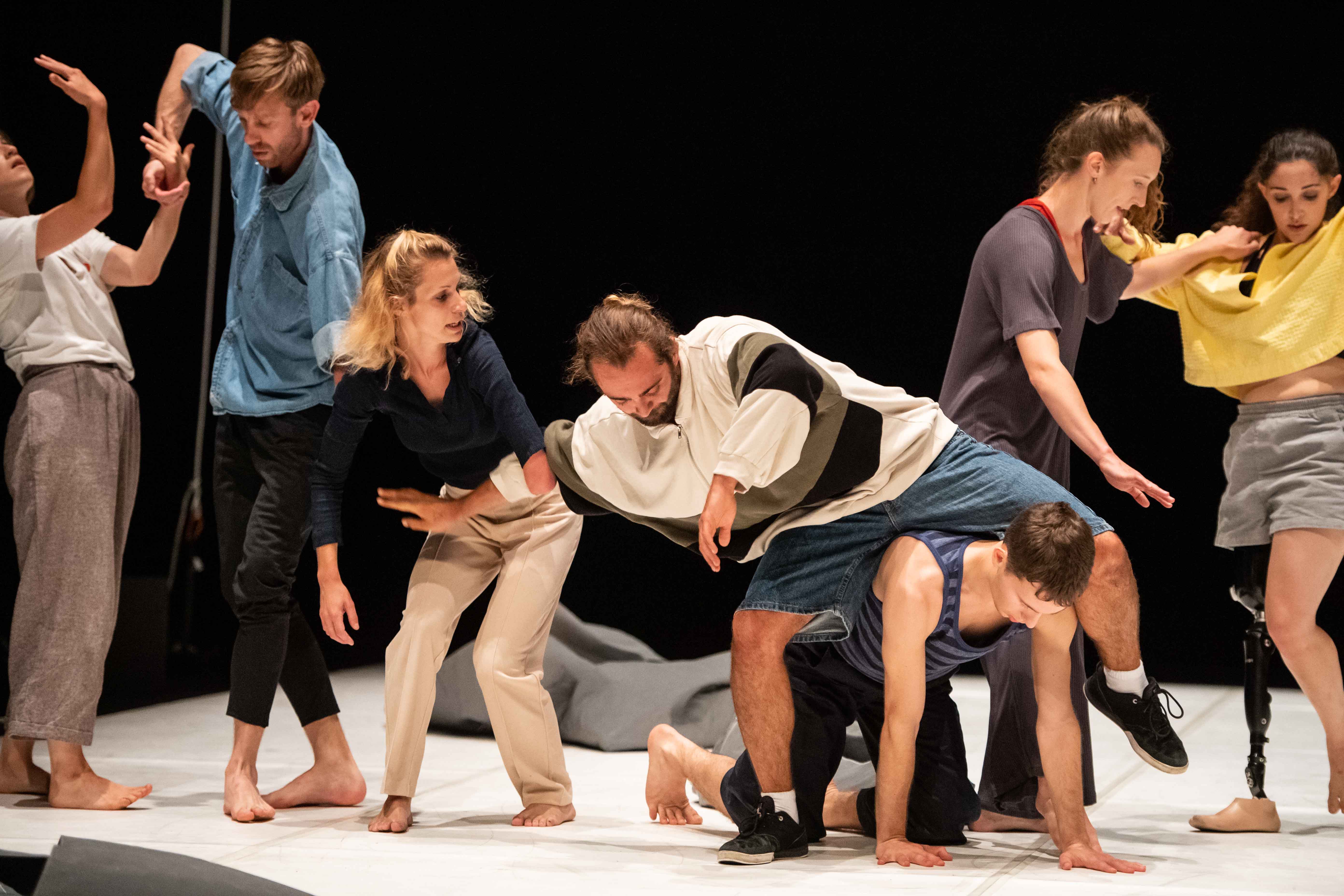Words by Adam Moore.
Homo sum,
humani nihil a me alienum puto.
Publius Terentius Afer, 163 BC
A meteoric burst of sound sends the curtain soaring, seemingly to the stratosphere; shrieking and peels of laughter ripple across an unsuspecting audience as they steady themselves, some still standing in the void of the interval. Unexpected and unconventional, Theo Clinkard’s Hot Mess performed by Candoco Dance Company starts with a bang. People skuttle down into their seats, rebellious giggles petering out, irreparably altering the atmosphere. Rattling in and out of exposed wings, up, down and across stage, dancers riotously tussle with engulfing, retro-reflective spools. Blurry, rapid, clattering across the stage, dancers brawl, spanking crude, grey forms into space, resisting being swallowed in a frenzy of strange material. Scraping fabric above the booming soundtrack and heavy breathing raking across the air eventually subsides. Uncertain what is being fought for, fervour eventually dissolves; breathless, scattered, the dancers come to from a fugue state. Halting, called to attention, there’s no clear victor. Collecting themselves on the naked stage, insouciant, vacant, available.
Quiet now, there isn’t time enough to think about the sudden spectacle shaking the stage, ambushing the audience. From somewhere indeterminate, the pace and concentration shifts, the dancers weaving, bobbing, spinning, clambering, between and amongst themselves, shifting obscurely into a determined, distinct, subtle attunement.
Sensing, anticipating and negotiating desire and intention, reconfiguring and adapting, the company’s individual nuances and varied physicalities of able and disabled bodies is poetic. More like the spontaneous prose of Kerouac than Keats it comes tumbling out seemingly unedited, and has a rhythm and punctuation that feels colloquial but isn’t delicate, precious or overly emotional: it feels real. Compositional, improvised group structures feel relatable and relational but not especially sensational. However, that’s what feels so fresh about this – fresh like taking a shower the night before, rather than the morning of; you feel good enough, but you’re not sparkling – and perhaps on a Sunday, you’re comfortable with that. Showing up relaxed, the dance has the appearance of carefully removing itself from their bodies, the dancers seemingly at ease with themselves and their performance, not trying to seduce you with the usual tactics.

The audience appears comfortable too, having got the initial fright out of their system; they seem happier than most audiences you might be surrounded by. Watching bodies dancing in this heartening aura opens up a window through which to look back momentarily. If this part of the work is the seductively mundane, lazy Sunday afternoon, perhaps the earlier shock is the unwelcome mid-morning mania? Alert to your lateness, opening your eyes, you spring into action, wrestling with the drudgery and impossibility of making up time, try as you might. Maybe that’s what it feels like to be a hot mess. Juxtapositions like these, smartly addressing questions raised by the ambiguity of the work’s title – without passing judgement on the cultural phenomenon – is reassuring; there is the sense that anything could happen, no matter how unspectacular, and that that is okay… quite arousing actually. Simmering rather than boiling, dancing takes on a persona of friendly camaraderie rather than the earlier skirmish, ‘every person for themselves’.
The distinction between this score ending and where the next begins has much less definition, unlike the previous shift down in gear. Rather than pulling the conventional punches we might expect, this feels like a change in step for commissioned works for Candoco Dance Company, the expectations of dance audiences (presumably), and Clinkard as a choreographer. There seems no crescendo, no climax, no trough; instead, a continuous unravelling. The grit needed to explore collective, improvised choreographic devices on stage, liberates a charming expression of what dance, and dancers, can be. Emphasising this is the diversity of able and disabled bodies and the possibilities these create together. Grasping the spontaneity made possible by the scores is simple, without the dancers making this simplistic; the primacy of the dancing human is fanciful, without becoming too fancy.
Police lights dangle from the rig overhead, tethered to the edges of the stage in the wings, promising much. Two or three dancers making adjustments are seen to be thinking – lower? No, higher. No. Lower – their preferences for intervention the determining factor. Manoeuvring the lights, dropping them into and hoisting them out of the space, has little gravity until… One dancer reaches out. Taking the light in their hand, they launch it with considerable velocity into an arcing pendulum of light. Swinging through the air at around naval height, to-ing and fro-ing, diminishing gradually, the shallowing beam delivers the goods, despite the instigator’s jaded reaction. Slowly, slowly; slowly, slowly…
Now. Scattered skips, skids, poses; wobbling into resolve… Now! Lithe legs fold, unfold; arms slice through the air; a hair flick; wheels spin, feet and tyres creaking to a halt… Now…? The dancers perform a series of accumulating call and response motifs built from dancing and its resolution into precarious stillnesses. NOW. A body flings across space; a twist, stomp-clap; a hard shunt, staggering to vertical. A wheelchair rolls slowly and silently, before clanking against the stage light fixed firmly downstage, metal on metal reverberating in the silence, met with some guffaw from the audience. It’s possible this has never been seen before – it doesn’t feel at all proper. But it does feel brilliant. And it couldn’t have been planned better.

Dance for gallery spaces continues to have its moment, as do the practices of visual artists ‘working with performance’. Few are the choreographers bringing visual art practices into dance for the stage. Contrary to what some might consider visual artist’s unethical consumption and near exploitation of dance, dancers and choreography, Clinkard authors the work, owning the concept, direction and set design, attributing the realisation and performance to the dancers, which feels honest and transparent. Clinkard is a dancer, and perhaps understands and protects dancer expertise and credentials more than visual artists are able to because of this. As a choreographer Clinkard has a flair for conceiving cohesive dances in combination with richly synthesised transdisciplinary practices, displaying an approach to dance that is vivid, subtle, raucous and elegant, offering audiences an alternative mode of attention, and bringing more oxygen into the room for germinating new ideas for the stage. Borrowing the mechanism of ‘the artist’s manifesto’ and introducing this prior to the start of the work feels useful, but could be the subject for panel discussion…
HOT MESS A MANIFESTO
| Rejecting: | Celebrating: |
| the stable – is anything? | the unformed – are we ever fully formed? Perhaps we are always forming, always possess the potential for more (or less)? |
| the fixed – all too often, fixing produces disease. Perhaps anchoring is better, more mobile a term that can be moved around? | the unknown – can we hold this lightly with the known? |
| the polished – maybe we can place more value on the cohesive? | the potential – YES!!! Yes… Yes. |
| the repeatable – maybe we don’t need to repeat? Or do we? Practice is built on this notion of repetition until mastery. But perhaps this can look different each time? | the collaborative – ‘even the lone artist in their studio is dependent upon contributions from others’ Brian Holms. Yes. |
| the product – what do we have for our labour if not this? What ways can we see what we are making outside of this capitalist terminology? | the unplanned – too much risk, and fear in ‘failing to prepare’? Plans make some people feel secure, others trapped. Perhaps we celebrate the contingency rather than the unplanned per se? |
| the heroic – see failure – but also, we need heroics, I need heroics, I need to feel heroic, sometimes. | the process – see the unformed |
| the known – can we hold this with the unknown? Can we have less anxiety about both? | the unexpected – see the unplanned |
| the formal – formality is a game we can all play but yes, let us throw this off: be humane? There’s still an etiquette to this but it originates from the heart and the gut, perhaps… | the failure – ‘Success is failure turned inside out– The silver tint of the clouds of doubt, And you never can tell just how close you are, It may be near when it seems so far’ – John Greenleaf Whittier. What do we want if we’re celebrating failure? Are we referring to something else when we celebrate? Hope, perhaps? What is failure? And what does that mean to you? Who gets to say? |
| the ordered – order and disorder feel like a never ending cycle and part of the same thing? | the queer – Yes. Mmmm. This might be becoming too trendy (in the creative field perhaps), with too little impact in wider society, however, the globe needs this. We forget how excluded queerness remains in society as a whole; including this in the manifesto is reassuring. However, no mention of other marginalised groups has entered into any aspect of this work – except the surprising relatively diverse audience. What does that say? Or not say? |
| the absolute – is there such a thing, let’s let go of this assumption? | the precarious – are we not but flesh and bone on a potentially fatally injured planet? ‘How precarious we are. Our days on earth are like grass; like wildflowers, we bloom and die’ Psalm 103:15 |
| the resilient – this is trixy, we need this, some more than others, but let’s say this is about dance, and let’s say this is still important? Perhaps some people need less resilience because unearned inclusion doesn’t require they develop this? | the disobedient – infers there is some higher authority? Let’s say this is about dance, dancing, dance conventions, dance discourse… YES. |
| the known – appearing twice, let’s expand on this one. Knowing can be comforting but this becomes maladaptive for some people when they allow this to become an obsession – to the extent that they cannot see and/or imagine anything else unsupported by facts, no conjectures into any other way of being, no other way of living, no possible change beyond reason; okay, let’s reject this rigid idea of ‘the known’. | the messy – Some mess is good, proof of the signs of life, like muddy shoes or oil-stained jeans. But when does mess become too much mess? This, like each point, seems personal. You decide how much mess is good for you… |
Hot Mess is fascinating in its opposition to choreographic and aesthetic spectacles and expectations and conventions of the theatre but resists conflating into some bizarre and joyless contemporary abstraction by white, middle-class males (even though Clinkard is a white, middle-class male). Despite the company’s lack of racial diversity, a work prioritising the person behind doing the dancing feels good for the stage and helpful for the times. People are important and their labour should be acknowledged. Not especially unsuccessful or disordered as the title might suggest, the work exists in a space that seems to hold the polarities of its manifesto, materialising as a softer, untangling thread of the shared personhood we might all one day be able to stand in comfortably. Candoco Dance Company might be the best company to perform this work and hopefully take ownership over it’s continual realisation as an innovative work within their repertoire. Joe Newman’s score is eclectic and blends itself to the work exceptionally well, but the conundrum of how to articulate the sound leaves no alternative other than to suggest going along to experience the work as a whole for yourself.
Hot Mess asks more questions than it answers, opening a window onto our own assumptions and judgements about (im)perfection and what arises when facing this reality. Less spectacular but more humane.
I am human, and I think nothing human is alien to me.
Publius Terentius Afer, 163 BC
Images: Stephen Wright.
